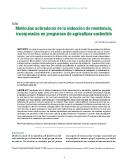| dc.description.abstract | Las plantas superiores han sido capaces de desarrollar una diversidad de mecanismos de defensa contra patógenos e insectos durante su evolución. Los patógenos también han co-evolucionado para ir superando estas barreras físicas y químicas. Es bien conocido que la resistencia es la regla y la susceptibilidad la excepción y, que estas complejas respuestas de defensa están bien reguladas, tanto espacial como temporalmente. Los factores que regulan las reacciones de defensa a infecciones son conocidas como moléculas activadoras o promotoras. Ellas inducen varias reacciones de defensa, tales como la producción de fitoalexinas, proteínas antimicrobianas, proteínas relacionadas con la patogenicidad, reacciones de oxidación y cambios estructurales a nivel de la pared celular, entre otras. Este artículo está enfocado al análisis de las moléculas activadoras, el papel que juegan en la interacción planta-patógeno o planta-insecto plaga, el entendimiento de los factores a nivel intra e intercelular que activan los mecanismos de defensa, la inducción de resistencia, la resistencia sistemática adquirida, la especificidad de la interacción y las múltiples vías de respuesta. Un mejor entendimiento de estos mecanismos permitiría a corto plazo, la aplicación de la inducción de resistencia en el marco de sistemas agrícolas sostenibles. During their evolution higher plants have been able to develop a diversity of defence mechanisms against pathogens and insects. Pathogens in turn have co-evolved to overcome these physical and chemical barriers. It is well known that resistance is the rule and susceptibility the exception, and that these complex defence responses are both spatially and temporally well coordinated. Factors that regulate the defence responses to infection are known as activator molecules or elicitors. They induce various defence reactions such as the production of phytoalexins, antimicrobial proteins, proteins related to pathogenicity, oxidation reactions and structural changes at the cell wall level, amongst others. This paper focuses on an analysis of elicitor molecules, the role they play in plant-pathogen or plant-insect pest interactions, an understanding of the factors at intra and intercellular levels which activate the defence mechanisms, the induction of resistance, the systemic acquired resistance, the specificity of the interaction and the multiple pathways of response. A greater understanding of these mechanisms will in the short term make it possible to employ the application of resistance induction into the framework of sustainable agriculture systems. | es_ES |


